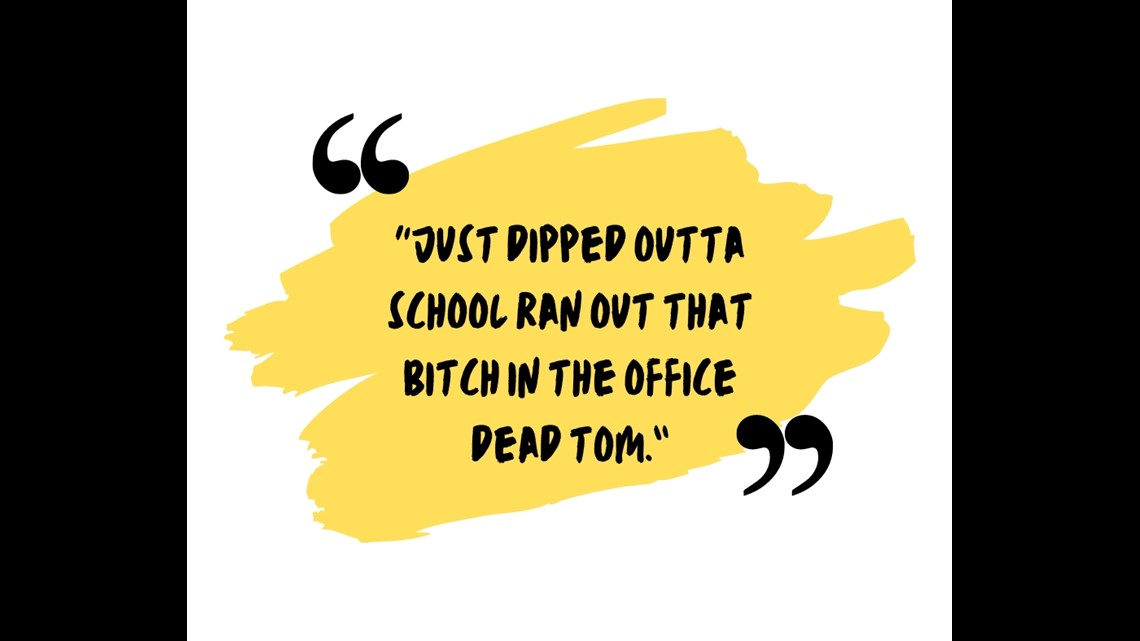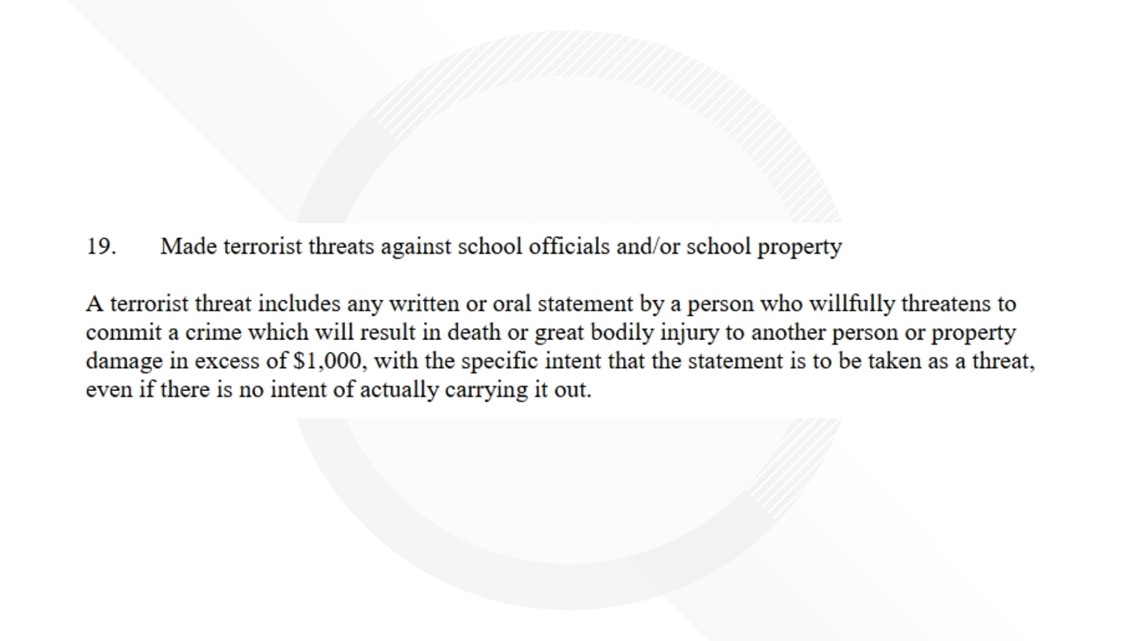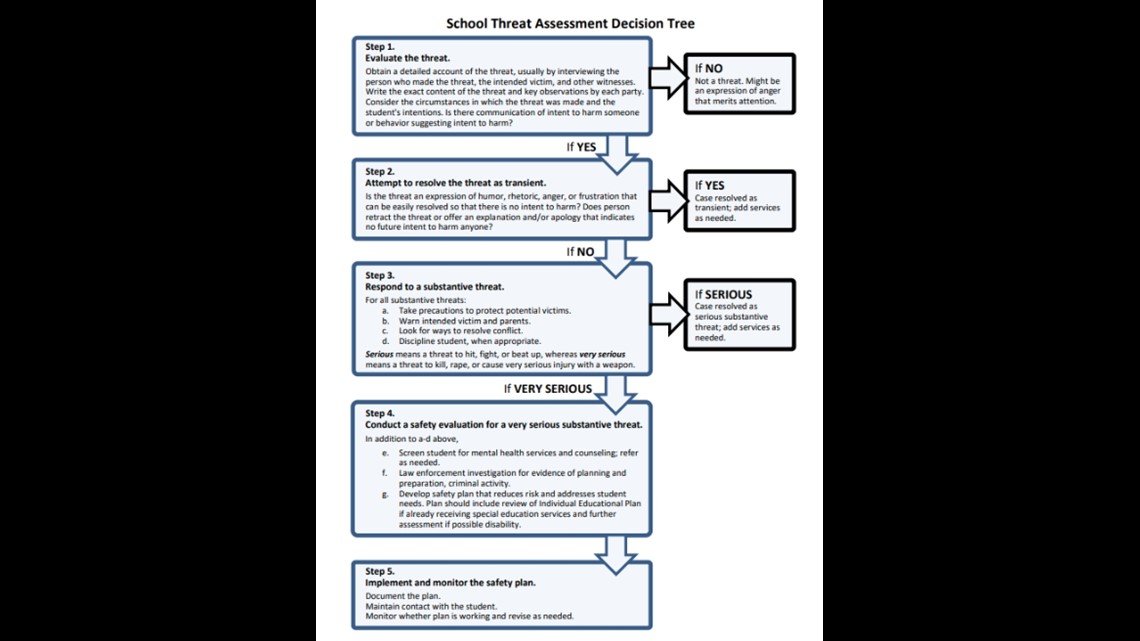San Diego District Attorney presses felony charge against 12-year-old over Snapchat message
The 7th grader ran out of the principal's office at Carmel Valley Middle School. His 13-word Snapchat post later that day would eventually lead to a felony charge.

The 12-year-old boy knew he was in trouble the moment he ran out of the Principal's Office at Carmel Valley Middle School in November of 2021.
He had no idea just what kind of trouble he would be in.
After running out of the principal's office, the seventh-grader logged onto Snapchat and wrote, 'Just dipped outta school ran out that bitch in the office dead tom.'
Hours later police arrested him and last month, a year after the message, San Diego County District Attorney Summer Stephan charged the boy with a felony, for making a criminal threat "that will result in death or great bodily injury."
The boy's mother says her son was saying the school principal jumped the gun by calling the police on what was not intended to be a threat but instead a message about how much trouble he was in.
The mother is now suing San Dieguito Union High School District for its handling.
She feels the district and the District Attorney are retaliating against her and her son for filing a lawsuit against the district and speaking out against her son's arrest and the school's response to what she says was a harmless social media post.
San Dieguito Union High School officials disagree.
The SnapChat Message 'Dead Tom'


On November 4, 2021, the then seventh-grader who we will refer to as, "Jacob," was approached by Carmel Valley Vice Principal Adam Bishop. The Vice Principal told Jacob that Principal Victoria Kim wanted to see him and that he needed to wait in Kim's office.
Jacob sat inside Kim's office for nearly two hours without hearing from Kim about what he did and the reason why he was inside her office.
At 3:20 pm Jacob's mother says Jacob's friends gathered outside of the office after the bell rang. They chanted his name and called on Principal Kim to "free 'Jacob'"
Jacob asked the office staff why he was there and if he could leave.
The office staff told him no.
A short time later, Jacob took matters into his own hands. He darted out of the principal's office to meet up with his friends.
Later that day, Jacob logged on to Snapchat where he wrote the following post: "Just dipped outta school ran out that bitch in the office dead tom.”
Jacob added a vampire emoji at the end of the message for emphasis.
Nine minutes after posting the message on Snapchat, Jacob deleted it. The damage, however, was done.
Response to Terrorist Threat Police Arrest Jacob
Jacob's mother, Emily, who wishes to remain anonymous to protect her son's identity, pulled into the parking lot of the family's apartment building.
She noticed several police cars in the parking lot but had no idea why.
When she arrived at her front door the police were waiting.
"I was scared because I didn't know why they were there. I was worried," said Emily. "I opened the door. They rushed to my son's bedroom. And he was sitting on his bed. He didn't have his socks or shoes, he didn't have anything on but they pulled him up and put him in handcuffs.
"He's like 80 pounds, four foot eight, max," says Emily. "He's got braces, you know, he's just a normal seventh grader."
After detaining Jacob, Emily says that the officers ransacked Jacob's room. They lifted up the beds, grabbed items from his closet, and looked through everything.
"I was screaming and asking why were they there. Why are they arresting my son?" remembered Emily. "At some point, one officer had said that he had made a death threat to his principal. I just remember my daughter screaming and I'm asking what was happening. The police were very aggressive and rude. They weren't explaining what they were there for. They weren't telling me what happened and they did not have a search warrant."
Emily says she struggles to get the memory out of the scene outside of her apartment that night.
"It is extremely traumatizing. Because the scene was so enormous downstairs with all the police officers and all the cars with their lights on, there were people standing waiting to see who is coming out of the building. And it was my little four foot eight, 80-pound 12-year-old in handcuffs with two police officers."
Jacob was later released from custody and was not booked on any charges.
Carmel Valley Middle School Principal Kim moved to expel Jacob from school over the threat.
Emily hired attorneys and fought the expulsion. The school board voted in Jacob's favor and voted against expulsion.
Felony Criminal Threat District Attorney Files Felony Charge
Attorney Diana Adjadj represents Emily and her son in the lawsuit that the mother and son filed against San Dieguito Union High School District.
The lawsuit claims that Carmel Valley Middle School Principal Kim and Vice Principal Adam Bishop failed to follow the proper threat assessment guidelines.
Days after Emily filed the lawsuit, Adjadj says the District Attorney filed a felony charge of making a "criminal threat."
"We have no doubt that this is retaliation," says attorney Adjadj. "There's been no new evidence since this happened last year. There's nothing, they sat back and didn't do anything. We had a representative from the school district reached out to us and now we know that they're aware of the civil complaint. And subsequently, there's, there are criminal charges. It's tactical, it's retaliatory."
The District Attorney's Office says it cannot comment on cases where juveniles are involved.
"The goal of the juvenile justice system is rehabilitation, which is what we work toward. Charges are overwhelmingly sealed so that the youth can grow without a criminal record."
The spokesperson did, however, add that the DA is serious about protecting the safety of students and school staff.
"We take school threats and threats to school staff very seriously, and we follow the established San Diego County School Threat Assessment Protocol when investigating and charging any potential threats to our schools. The protocol exists as a uniform way to reduce risk and prevent violence. Generally speaking, there can be a lag time from when a school threat incident happened to when it is submitted to our office for review. That time can be extended as the original reports do not have the investigative information we need. These cases require a lot of investigative follow-ups."
The Intent Threat or No Threat
Preventing school shootings has been a key priority for educators and lawmakers across the country.
Images from Uvalde, Oxford, Virginia, where students from elementary school age to college students have been gunned down, have prompted school districts and law enforcement to view any threat as the next school tragedy.
Despite having placed more focus, the problem persists, with this year seeing a record number of school shootings. Data compiled by Education Week shows that there were 46 school shootings so far this year. That is the highest single-year tally, according to Education Week, since the publication first began tracking school shootings in 2018.
With more young people using social media on their smartphones, the number of reported threats around school safety has grown dramatically and school officials and law enforcement are making quick decisions on if those threats are false or credible.
Ken Trump is an expert in school safety and President of National School Safety and Security Services in Cleveland, Ohio
Trump has testified in high-profile school shootings in Sandy Hook, Parkland, San Bernardino, and others.
Trump says it is important when looking at a potential threat to remember that schools are community-based centers and that there is a need to "strike a balance between having reasonable risk reduction and security measures, while also not going overboard to the point where you negatively impact the school climate"
Added Trump, "Schools are for children. They're different from the courthouse, the government facility and military installation. We're dealing with kids, we're dealing with young people, we're looking at school climate, we're looking at age and developmental issues, and kids, unfortunately, do and say silly things, stupid things, and bad things. So you want to make sure that every threat needs to be treated seriously. It needs to be investigated thoroughly. But the outcomes the consequences should vary based on the context of the situation, the age and developmental aspect and the credibility, nature planning and overall credibility of the threat itself."
Emily says Jacob's message wasn't a credible threat, in fact, it wasn't a threat at all.
"He was saying he was in trouble," Emily told CBS 8. "These kids have the slang you know, they have their own verbiage...he meant that he is dead tomorrow. He is going to be in the office dead tomorrow. He left school. He's in trouble. He had called me immediately after leaving the school and said, Oh my gosh, Mom, I was in the office for over two hours. I don't know why I was in there. They put me in the counselor's room. They didn't even turn the lights on for me. I asked to use the bathroom twice. They wouldn't let me. I left the office. Mom, please don't be mad at me. Please don't be mad at me."
But oftentimes, says Trump, school administrators, and school districts act without much guidance on just how they should go about determining whether a threat is credible, or, in Emily's opinion, even a threat at all.
San Dieguito Union's Response School Safety
And while Emily says her son's post on social media may have been harmless, it ultimately is up to school administrators, in this case, Principal Kim, to interpret the message while trying to ensure the safety of her students and faculty members.
"The San Dieguito Union High School District takes student safety very seriously. Every student, teacher and staff member has a right to feel safe when they come to school or their place of work," said a district spokesperson when asked about the incident.
The spokesperson said that it could not comment further about the particular case but said students are provided a handbook at the beginning of the school year that outlines what is expected of them while at school.
"The privacy of our students and their families is an inherent right for all members of the San Dieguito Union High School District community as afforded to them by the Family Educational Rights and Privacy Act. Thus, the district does not and cannot comment on individual students academic or disciplinary records. Carmel Valley Middle School provides a student agenda with behavioral expectations to all students at the beginning of the year."
The district also provided the following policy in regard to discipline and what qualifies as a threat.
"Made terrorist threats against school officials and/or school property. A terrorist threat includes any written or oral statement by a person who willfully threatens to commit a crime which will result in death or great bodily injury to another person or property damage in excess of $1,000, with the specific intent that the statement is to be taken as a threat, even if there is no intent of actually carrying it out."


San Dieguito Union Threat Assessment
And while the district provided discipline guidelines for students who threaten violence at school, it did not provide the policy it has when investigating the perceived threats.
In recent years, school districts have implemented "threat assessment" guidelines to weed out what are harmless or poorly worded social media posts or text messages from students.
The San Diego County Office of Education which provides resources for schools throughout the county adopted a threat assessment in 2021.
"In conjunction with the San Diego County District Attorney’s office, the San Diego County Office of Education released the San Diego County School Threat Protocol guidance document. The San Diego County School Threat Protocol is designed to promote the safety of students across San Diego County and to facilitate a coordinated response to threats of school violence," said a spokesperson from the County Office of Education.
The protocol includes a "school threat assessment decision tree" that is intended to guide principals and school officials while encountering a potential violent threat.
The first step suggests administrators "evaluate the threat" by interviewing the student who made the statement, as well as interviewing other witnesses, and considering the student's "intentions" and whether or not they intend to harm someone.
If after doing so and there was no intent to do any harm, then administrators should find that the message or statement was, according to the protocol, "not a threat."


The spokesperson for the district would not confirm whether or not it followed the threat assessment protocol.
Meanwhile, Emily says the answer is clear.
"Nothing was done other than the principal interpreting the post, then notifying the police, and then the police arresting my son," said Emily. "There was no, let's call the parents, let's get the kid, and let's talk about what this actually meant. None of that it was just the principal's interpretation, calling the police saying that there was a death threat."
It is that kind of interaction and follow-up that needs to occur before getting police or law enforcement involved.
"Teens and younger kids communicate in hieroglyphics," said Trump. "Entire sentences are now written out through emojis. The adults need to ask themselves what's the actual message. We can benefit by really just sitting down with the kids. And having a conversation, we can really benefit by having a conversation with the kids, the parents, and maybe your police officer to say, what is this? What does it mean, translate it, tell me that context still can be a bad decision. So it could be inappropriate. But it also can be one of those things that kids say stupid things and inappropriate things, let's say those that rise to a criminal level for those that are really crimes."
Because of the language gap, Trump says it is even more important for school districts nationwide to adopt a threat assessment or protocol to ensure that each alleged or perceived threat is handled to not only protect student safety but also student rights.
Free Speech or Threat Weighing Safety Over First Amendment
But for attorney Adjadj who represents the family, there are also constitutional rights at stake and freedom and speech and expression.
"What happened was unjust, it was unconstitutional," says Adjadj. "You know, we often forget, that minors have constitutional rights as well. Here, the minor had the right to freedom of expression, freedom of speech, access to education, and to not be subjected to unreasonable searches and seizures. These violations occurred, all because of one social media post that was misinterpreted by the principal."
In January of this year, the United States Supreme Court ruled that schools should take a back seat when disciplining students from off-campus free speech.
In the case, Mahonoy Area School District vs. B.L., high school administrators kicked a cheerleader off of the team and disciplined her after she posted the following on Snapchat, "F*%k school f*%k softball f*%k cheer f*%k everything.”
The majority of the court found that schools have limited control over off-campus speech on social media and that it falls on parents and not schools to censor or try and limit off-campus speech.
Wrote Justice Steven Breyer, "America’s public schools are the nurseries of democracy. Our representative democracy only works if we protect the 'marketplace of ideas.' This free exchange facilitates an informed public opinion, which, when transmitted to lawmakers, helps produce laws that reflect the People’s will. That protection must include the protection of unpopular ideas, for popular ideas have less need for protection..."
"We're Fighting For His Justice" Moving Forward
Despite the guarantees provided in the ruling, Emily says the school district blatantly retaliated against her and her son after they were victorious in Jacob's expulsion hearing.
In order to avoid any future issues at Carmel Valley Middle School, Emily enrolled Jacob in a private school. Not long after enrolling, Emily says the school notified her that San Dieguito Union sent a letter to the school informing them that Jacob had made a threat against his middle school.
"My son just started at the new school when the school told us that they had gotten a letter that my son had made a terroristic threat at his prior school. Being a private school, they said that they couldn't take that risk of other families, you know, possibly hearing about it or knowing about it. And so they told us that he was not welcome to come back."
Jacob has since moved to another private school.
Meanwhile, the mother and son vow to continue their fight.
"We don't want it happening to other people. I want my son to know that we're fighting for his justice. I mean, what he had to go through will stay with him forever. My son was arrested at 12 years old, put into handcuffs by two officers, and pulled out of my home. He will live with that for the rest of his life."


